
THE 2024 ROADY'S ANNUAL CONFERENCE IS COMING!
Join us in Las Vegas for Networking Opportunities, Educational Seminars, New Technologies, and Racing Really Fast Cars - Find out more at https://conference.roadys.com
Fuel is big business in the trucking industry. A single truck within a fleet drives an average of 120,000 miles per year, using roughly 20,000 gallons of fuel.
Fleet managers need a way for drivers to purchase all that fuel without worrying about unauthorized use. Drivers need to swipe and go. And fleet owners are always looking for ways to streamline operations and save on costs.
Truck stops can help meet those needs by accepting fuel cards in addition to credit cards and other forms of payment.
Drivers use fuel cards to purchase fuel and vehicle maintenance services and products from authorized gas stations and other businesses. The fleet manager is able to set limits for their use — such as no purchases from convenience stores — and to monitor each transaction. The cards offer a way to obtain fuel discounts, as well as to improve security and save administrative hassle and time, improving a carrier company’s bottom line.
There used to be several companies offering fuel cards, but those have been whittled down to two main players: Fleetcor (Comdata, Fuelman) and Wex (EFS, T-chek, TCH, FleetOne). When transacting with any fuel purveyor in each network, drivers use cards issued by either of these companies to simply transact quickly and be on their way, as with a normal credit card.
Imagine that a growing trucking company has just hired a new driver. Instead of dishing out a corporate card and praying the driver is honest, the fleet manager can issue a fuel card that allows for control and monitoring of how the new employee transacts. For example, the card might limit how much diesel #2 and oil the driver can purchase and whether other transactions are allowed — for example, buying some diesel exhaust fluid … and what about a shower? The manager can monitor these transactions and other metrics like how many miles occur between each fill-up.
Fleet owners and managers will find great value in these cards both in the discounts they can provide and in the savings of administrative time they enable. Fuel cards have a discount structure that can be implemented at the point of purchase, which is difficult to do with cash, check, or regular credit cards.
Additionally, simplifying the logistics and increasing the security of refueling and maintenance frees up staff to focus on growing and strengthening the business instead of dealing with paperwork and administrative hassles.
If a truck stop already accepts credit cards, dealing with fuel cards may seem unnecessary. But getting set up to take this payment option will bring new business from fleets whose drivers are restricted to transacting this way.
Most fleets with at least 50 trucks use some sort of a fuel card, so not accepting Wex and Fleetcor cards means missing the business of most larger carrier companies. Those drivers attracted by the ability to fuel up at a given truck stop may then spend more of their own money there to fulfil their own personal needs.
As with credit cards, when a driver uses a fuel card the truck stop receives the retail price minus the credit card transaction fees. With fuel cards, roughly speaking the processing fee for each transaction paid by the retailer is $0.08 - $0.10/gallon or 2.0% - 3.0% of the fuel transaction price.
Let’s look at this in practice. Imagine that diesel is retailing at $2.50 per gallon, with a wholesale price of $2.30 per gallon. At a truck stop, a driver swipes a fuel card for 100 gallons, paying $250 total. The fuel card company charges the fleet $250 plus any out-of-network fees.
If the driver is transacting with Fleetcor, let’s say for example Fleetcor keeps $0.08/gallon, totaling $8, then sends the remainder of $242 to the truck stop. The truck stop thus earns $12, or $0.12/gallon, after subtracting the $230 wholesale fuel cost and the $8 transaction fee.
If the driver is using a Wex card, let’s say for example Wex keeps 2% of the transaction, or $5, then remits the remainder of $245 to the truck stop. The truck stop earns $15, or $0.15/gallon, after subtracting the $230 wholesale fuel cost and the $5 transaction fee.
The two main providers control over 80% of the fuel card market. With that market coverage, there isn’t a ton of competition to force a reduction in processing fees that retailers pay.
This market penetration means extremely big business for these two players. For example, if a carrier uses an average of 20,000 gallons of fuel per year, Fleetcor may earn over $1,600 in transaction fees from that single truck in one year. Assuming the fuel costs $2.50/gallon, Wex may earn over $1,000 in a year. For a fleet of 100 carriers, then, Fleetcor could earn $1,600,000 in annual processing revenue while Wex could earn $1,000,000.
But competition is coming! Mobile pay, which bypasses the fuel card system completely, is rolling out from providers like Mudflap and P97. This new technology could eat into the market share of Fleetcor and Wex while reordering how trucking companies transact for fuel.
In the meantime, Fleetcor and Wex are starting to feel the pinch as bigger companies like Loves, Pilot, and TA negotiate lower transaction fees for the use of fuel cards at their massive chains of stops.
Technology progression assures changes are coming as players in this space strive to remain competitive and keep market share. Carriers, fleets, and truck stops are the winners — fuel cards allow drivers to transact quickly and reliably, fleet companies to reduce their management burdens, and truck stops to sell more fuel and other amenities to a broader range of customers.
Here’s what we've been up to recently.